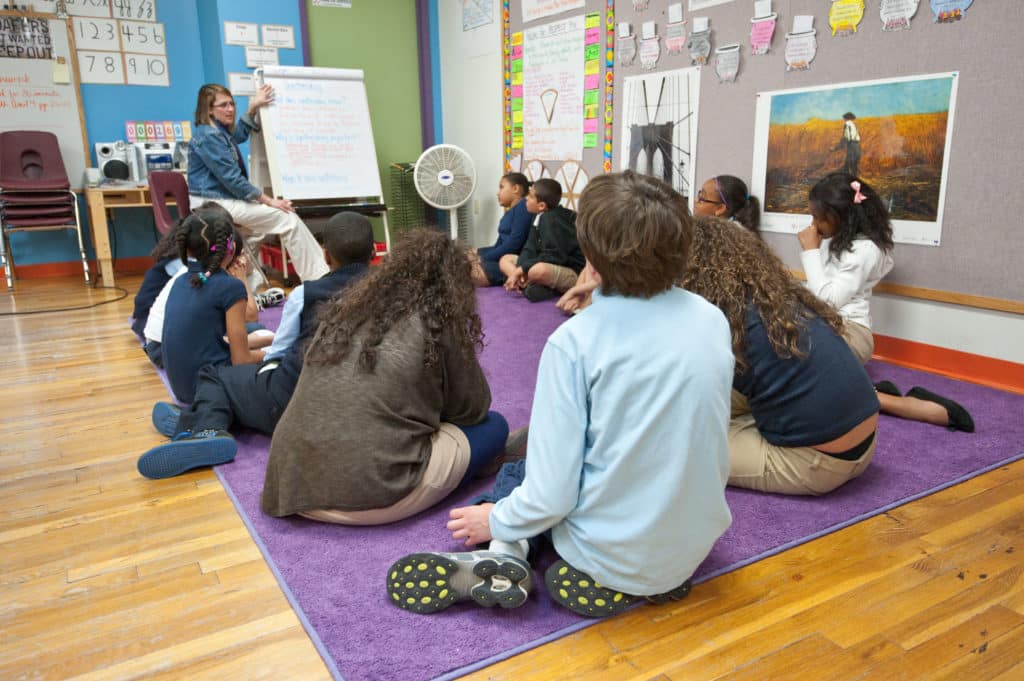
The following is adapted from Rules in School.
From the first day, lay the foundation for a successful year by letting students know what behavior you expect. Modeling classroom routines takes time, but it’s time well spent! By creating a sense of order, predictability, and trust in your classroom, you send the message that respect, kindness, and learning will prevail.
These first weeks are the time to establish signals for quiet, set guidelines for class discussion, and introduce the basic daily routines of your classroom: lining up, taking out and putting away materials, and what to do if students finish work early.
Children are able, even eager, to rise to high standards of behavior, but they need to know exactly what those standards are. Often we assume students already know what we expect of them, when they may not. When you use the technique of explicit modeling, you make your expectations clear and easier for students to meet. Here is a modeling procedure to follow:
Modeling is not only a successful strategy, it’s quite fun and helps children develop their assertiveness and empathy skills.
“Kids are far more interested in following rules they help to create. It’s that simple,” says Gail Zimmerman, a second-grade teacher in Boston, Massachusetts. Many teachers would agree. Have faith that children can make sense of rules and want to follow them.
Rules give children a sense of security and belonging, especially rules that they view as reasonable and fair. Start by talking to your class about your hopes for the coming year and ask them to articulate their own goals for the school year. Encourage them with specific questions: “What’s important to me at school? What do I want to get better at? What do I care about?” Younger children can share their hopes and dreams verbally, and then draw pictures of their most important hope. Older children can move from the initial conversation to writing in their journals.
Sharing individual goals for the year produces a meaningful context for creating classroom rules. Ask: “What rules do we need to make our hopes and dreams come true?” Generate a list of preliminary rules together, emphasizing that the rules are there to help everyone succeed. Help children to frame their ideas in the positive: for example, suggest changing “Don’t be rude” to “Use a friendly voice.”
Finally, work with students to categorize the rules into a few simple global rules, as discussed in the next point.
Walk into any classroom using the Responsive Classroom approach and you’ll see a chart of three to five rules, such as “Respect each other,” “Take care of yourself,” and “Take care of classroom property.” Rather than listing all the possible dos and don’ts, these rules act as guiding principles and remind students in a global way of what they should do. Broad rules foster ethical thinking and the practice of self-control by giving children the opportunity to apply general behavior expectations to various situations.
After working on the process of creating the rules together, celebrate your final short list of rules by having children make a beautiful poster display of them. Then publish the rules in a letter home to families, inviting support.
The language we use is one of our most important teaching tools. What we say and how we say it carry tremendous weight in the classroom. Our language can build children up or tear them down. It can model respectful and caring social interactions or just the opposite. Effective language encourages and empowers children to respect and follow the rules, rather than criticizing for not following them.
Effective teacher language:
Sometimes the most effective teacher language is to say very little. A visual or verbal cue may be all that is needed to help a child get back on track.
Children will break the rules. They will forget, become unsure, and test limits. All of your proactive strategies—everything from discussing hopes and dreams to using careful teacher language—have built a strong foundation for a caring learning community. Be ready to follow up with effective reactive strategies—most important, the use of logical consequences.
Logical consequences are a way to help fix problems that result from children’s words and actions when they break or forget rules. They help children regain self-control, reflect on their mistakes, and make amends for them. Logical consequences should be respectful of the child, relevant to the situation, and reasonable in scale. Here are three types to consider:
No matter how carefully we lay the groundwork for a positive classroom community, we know that there will be times in the year that try our patience and goodwill. There will be moments, perhaps even many moments, when it’s a struggle to think of a logical consequence when a child breaks a rule, or to find the teacher language or the calm voice you want to use.
Forgive your minor slip-ups. Like the children, we will make mistakes, and like the children, we need to be able to go back and try again. When you can, give yourself a minute to “take a break,” or at least a deep breath. Remember to ask for the support you need from other teachers, and to offer your support to them.
Sharing your ups and downs can help you find the humor in a situation. At the end of the year when you reflect on the rules as a class, you’ll see the difference. As one child said of a classroom that took this approach: “People are nice to each other in this class, and it is a nice place to be.”